| |
|

This special edition of
Perspectives in Lens & IOL Surgery brings
you news only available in EyeWorld. I am
confident that when you read this column, you
will find it offers pearls that will help you
and your colleagues better confront the
challenge of intra-operative floppy irides
during cataract surgery.
The idea for this
column developed a few months ago when John R.
Campbell (M.D., San Rafael, Calif.) observed me
in surgery.
The first two cases he observed
were characterized by extremely intractable
small pupils associated with intra-operative
floppiness. Dr. Campbell commented that he
suspected that both of these male patients took
the prescription drug Flomax (tamsulosin
hydrochloride, Boehringer Ingelheim GmbH,
Germany). I asked the patients and, indeed, each
answered ‘yes.’
Dr. Campbell indicated that
a retrospective review in his surgery center
discovered a link between this medication and
intra-operative floppy irides during cataract
surgery.
Subsequently, Dr. Campbell and David
Chang (M.D., University of California, San
Francisco) conducted a major study of this
phenomenon. They generously agreed to share
their findings with EyeWorld.
Dr. Chang, as
most readers of this column know, is a leader in
cataract surgery technology, techniques, and
teaching. He is a terrific source of information
and inspiration to practicing physicians and has
recently been named to the Cataract Clinical
Committee of the American Society of Cataract
and Refractive Surgery.
When you read this,
I’m certain you’ll agree the research by Drs.
Chang and Campbell provides a valuable
contribution to cataract surgery.
I. Howard Fine,
M.D.
Column
Editor |
|
|
Consider this scenario:
As you begin cataract surgery, you notice that
the patient’s pupil is poorly dilated.
You
perform your usual method of mechanical pupil
stretching, perhaps adding partial thickness
sphincterotomies. This affords a large enough
pupil to perform a capsulorhexis.
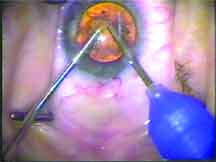
Commencing bimanual MICS
in a Flomax patient with a well
dilated
pupil.
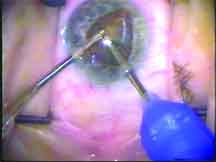
Pupil constriction accompanies
iris billowing and prolapse to
1.2 mm
phaco incision.
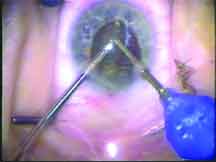
Progressive intraoperative
miosis with prolapse to both
1.2 mm
incisions.
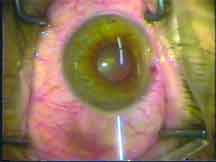
Poor pre-operative dilation
despite discontinuing Flomax
for 2
weeks.
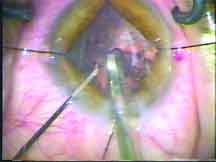
Iris retractors maintain
adequate pupil size.
Diamond
configuration
improves sub-incisional
access to epinucleus.
Note iris prolapse
to
side port incision.
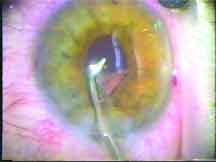
Following IOL insertion and
retractor removal, pupil
billows,
prolapses, and
constricts during removal
of viscoelastic.
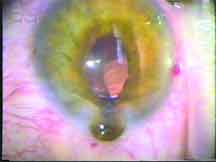
Strong tendency to prolapse
despite stopping Flomax
preoperatively
and using
iris hooks.
Source: David
F. Chang, M.D.
Our
suspicion is that you have probably encountered
such a case.
Having found no such
description in the peer-reviewed literature, we
have named this condition the intra-operative
floppy iris syndrome (IFIS). It is characterized
by repeated incisional prolapse of a floppy
iris, causing progressive intra-operative miosis
that is not prevented by sphincterotomies and
mechanical pupil stretching. The pupil often
dilates poorly pre-operatively.
Study particulars
We have just completed both a
retrospective and a prospective study of IFIS,
the results of which have been submitted for
publication and will be reported at the next
ASCRS•ASOA symposium and congress (April 15–20,
2005, Washington, D.C.).
In these two series
of more than 1600 combined patients, we found
overwhelming evidence that IFIS is caused by
tamsulosin hydrochloride (Flomax, Boehringer
Ingelheim GmbH, Germany), a systemic alpha-1
antagonist medication. This drug relaxes the
smooth muscle in the bladder neck and prostate,
improving urinary flow in patients with
symptomatic benign prostatic hypertrophy (BPH).
Flomax is highly selective for the alpha-1A
receptor subtype that predominates in the
prostate. It is therefore more uroselective
compared with other alpha-1 blockers for BPH,
such as Hytrin (terazosin hydrochloride, Abbott
Laboratories, Abbott Park, Ill.) and Cardura
(doxazosin mesylate, Pfizer, New York). For this
reason, it is currently the most commonly
prescribed medication for BPH. Interestingly, we
did not find that Hytrin or Cardura caused
IFIS.
Our review of the pharmacologic
literature suggests that the same alpha-1A
receptor subtype is also present in the iris
dilator smooth muscle.
We postulate that
prolonged pharmacologic blockade results in loss
of normal iris dilator smooth muscle tone. This
deficient tone produces the floppy iris behavior
caused by normal intraocular fluid currents
during surgery.
Clinical
implications
There are several
important clinical implications of this
association. First, pre-operatively, male
patients should be questioned about Flomax use,
particularly if the pupil dilates poorly.
Because of its long half-life, we advise
temporarily stopping this medication for two
weeks before cataract surgery. In our
experience, we found that this improves but does
not eliminate the floppy behavior of the iris.
This suggests a more lasting effect of Flomax on
the iris dilator smooth muscle.
With respect
to surgical technique, one should pay particular
attention to proper incision construction, and
avoiding excessive injection of an ophthalmic
visco-device or hydrodissection fluid.
We
strongly recommend the use of iris hooks or an
iris expansion ring to maintain an adequate
surgical pupil diameter. In general, these
measures are less commonly used for small pupil
management because of the additional surgical
time and cost involved.1 They are also difficult
to insert without ensnaring the capsulorhexis
once the latter has been
completed.
Therefore, anticipation of IFIS
allows the surgeon to reconsider their usual
methods of small pupil management in favor of
self-retaining pupil expansion devices inserted
prior to capsulorhexis initiation. If disposable
iris retractors are used, we favor the diamond
configuration recommended by Oetting and
Omphroy.2 Finally, we have tried bimanual
microincisional phaco in these IFIS eyes,
expecting that the tighter incisions might
prevent iris prolapse. If the pupil is
reasonably well dilated, or if iris hooks are
used, the ability to keep the irrigation flow
more consistently anterior to the iris plane
seems to reduce iris billowing and prolapse.
However, if the pupil is small, we found that
billowing and prolapse still occur, even through
the tighter 1.2 mm
micro-incisions.
In conclusion, IFIS is a newly described
small-pupil syndrome caused by a medication that
is commonly used in the elderly male population.
Because of the higher risk for posterior capsule
rupture and iris trauma associated with IFIS
cases, we believe that recognizing and
anticipating these cases will be important in
enabling surgeons to reduce the complication
rate.
Editors’
note: The authors have no
financial interest in any products mentioned.
About the
Authors

|
David
Chang, M.D., clinical professor,
University of California, San Francisco and in
private practice in Los Altos, Calif. Contact
him at 650-948-9123, fax 650-948-0563, dceye@earthlink.net
|
 |
John R.
Campbell, M.D. is in private practice
in San Rafael, Calif. Contact him at
415-454-5565, fax 415-454-2957, JRC@MarinEyes.com |
References
1.
Akman A, Yilmaz G, Oto S, Akova Y. Comparison of
various pupil dilatation methods for
phacoemulsification in eyes with a small pupil
secondary to psueudoexfolication. Ophthalmology
2004;111:1693-1698
2. Oetting TA,
Omphroy LC. Modified technique using flexible
iris retractors in clear corneal surgery. J
Cataract Refract Surg. 2002;
28:596-598 |